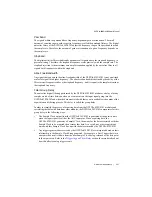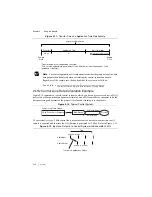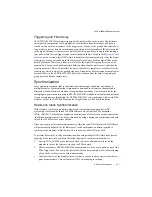
© National Instruments
|
2-3
Figure 2-3.
Connecting Floating Signal Source with Balanced Bias Resistors
Both AI+ and AI- require a DC path to ground. If the source is AC coupled, a resistor is required
between the positive input and AIGND, as shown in Figure 2-4. If the source has
low-impedance, choose a bias resistor for the positive input that is large enough not to
significantly load the source, but small enough not to produce significant input offset voltage as
a result of input bias current. Connect the negative input directly to AIGND.
Figure 2-4.
Connecting AC Coupled Floating Sources with Low Impedance
If the source has high output impedance and is AC coupled, balance the signal path as previously
described with balanced bias resistors using the same value resistor on both the positive and
negative inputs, as shown in Figure 2-5. Be aware that there is some gain error from loading
down the source.
Figure 2-5.
Connecting AC Coupled Floating Sources with Balanced Bias Resistors
PXIe-4
3
02/4
3
0
3
TB-4
3
02
AI+
AI–
AIGND
+
–
Flo
a
ting
S
ign
a
l
S
o
u
rce
AI+
AI–
AIGND
R
R
V
s
PXIe-4
3
02/4
3
0
3
TB-4
3
02
AI+
AI–
AIGND
+
–
AC
Co
u
pled
Flo
a
ting
S
ign
a
l
S
o
u
rce
AI+
AI–
AIGND
AC
Co
u
pling
V
s
R
Low
Imped
a
nce
(<100
Ω
)
PXIe-4
3
02/4
3
0
3
TB-4
3
02
AI+
AI–
AIGND
+
–
AC
Co
u
pled
Flo
a
ting
S
ign
a
l
S
o
u
rce
AI+
AI–
AIGND
AC
Co
u
pling
V
s
R
R
High
Imped
a
nce
(
≥
100
Ω
)











































